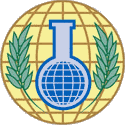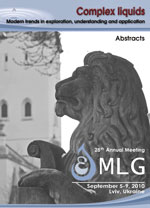Statics and dynamics of colloidal particles in liquid crystals
Oleg Lavrentovich
e-mail: olavrent
 kent.edu
kent.edu
Liquid crystals (LCs) produce a rich variety of complex 3D structures that are easily changed by external fields, boundary conditions, embedded particles, etc. In the latter case of a liquid crystal with colloidal inclusions (liquid crystal colloid), the equilibrium is often achieved by introducing topological defects in the director field, stabilized by surface anchoring at interfaces [1]. This report reviews the basic properties of liquid crystal colloids such as elastically-mediated interactions of colloidal particles and then presents recent experiments on the dynamics of particles in the nematic and smectic liquid crystals driven by AC and DC electric fields [2-4]. The 3D director structure around the particles is visualized by fluorescence confocal polarizing microscopy (FCPM). The electric field causes translation and rotation of the colloids. The underlying mechanisms include specific liquid crystal effects such as backflow (coupling of director reorientation and mass flow) and mechanisms of general nature, such as electrophoresis, dielectrophoresis, electrorotation and hydrodynamic interaction between the particle and a confining wall. These general mechanisms acquire new, sometimes unexpected, facets when the action is staged inside a liquid crystal. The work has been supported by NSF DMR, DOE, W.M. Keck Foundation, CMPND.
References
- H. Stark, Physics of colloidal dispersions in nematic liquid crystals, Phys. Reports, 351, 387 (2001).
- O. P. Pishnyak, S. Tang, J. R. Kelly, S. V. Shiyanovskii, O. D. Lavrentovich, Lift and bidirectional motion of colloidal particles in an electrically-driven nematic liquid crystal. Phys. Rev. Let., 99, 127802 (2007).
- A. Jakli, B. Senyuk, G. Liao, O.D. Lavrentovich, Colloidal micro-motor in smectic A liquid crystal driven by DC electric field, Soft Matter 4, 2471-2474 (2008).
- O.D. Lavrentovich, I. Lazo, O. P. Pishnyak, Electrophoresis of dielectric and metal particles in liquid crystals (in preparation, 2010).



